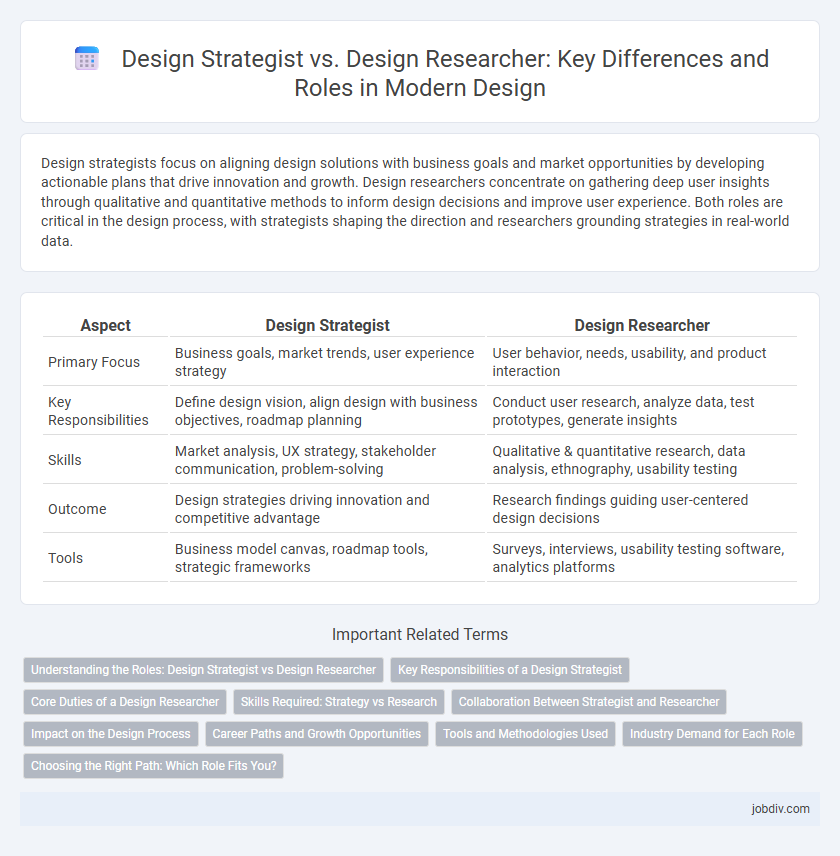Design strategists focus on aligning design solutions with business goals and market opportunities by developing actionable plans that drive innovation and growth. Design researchers concentrate on gathering deep user insights through qualitative and quantitative methods to inform design decisions and improve user experience. Both roles are critical in the design process, with strategists shaping the direction and researchers grounding strategies in real-world data.
Table of Comparison
| Aspect | Design Strategist | Design Researcher |
|---|---|---|
| Primary Focus | Business goals, market trends, user experience strategy | User behavior, needs, usability, and product interaction |
| Key Responsibilities | Define design vision, align design with business objectives, roadmap planning | Conduct user research, analyze data, test prototypes, generate insights |
| Skills | Market analysis, UX strategy, stakeholder communication, problem-solving | Qualitative & quantitative research, data analysis, ethnography, usability testing |
| Outcome | Design strategies driving innovation and competitive advantage | Research findings guiding user-centered design decisions |
| Tools | Business model canvas, roadmap tools, strategic frameworks | Surveys, interviews, usability testing software, analytics platforms |
Understanding the Roles: Design Strategist vs Design Researcher
A Design Strategist focuses on aligning design solutions with business goals by integrating market insights, user needs, and competitive analysis to create actionable strategies. A Design Researcher specializes in gathering and analyzing qualitative and quantitative data through user interviews, usability testing, and ethnographic studies to inform design decisions. Both roles collaborate to ensure design outcomes are user-centered while driving innovation and achieving organizational objectives.
Key Responsibilities of a Design Strategist
A Design Strategist focuses on aligning design initiatives with business goals, identifying market opportunities, and creating actionable roadmaps that drive innovation and user engagement. They analyze competitive landscapes and customer insights to inform design decisions and ensure sustainable growth. Their role bridges the gap between creative teams and stakeholders, facilitating strategic planning and implementation.
Core Duties of a Design Researcher
Design researchers focus on gathering and analyzing user insights to inform product and service development. Their core duties include conducting qualitative and quantitative research methods, such as interviews, surveys, and usability testing, to uncover user needs and pain points. They synthesize data into actionable recommendations that guide design teams in creating user-centered solutions.
Skills Required: Strategy vs Research
Design strategists excel in skills like market analysis, business acumen, and user experience mapping to craft comprehensive design solutions aligned with organizational goals. Design researchers specialize in qualitative and quantitative research methods, behavioral analysis, and data interpretation to uncover user needs and validate design concepts. Both roles require collaboration and critical thinking, but strategists prioritize strategic planning while researchers emphasize evidence-based insights.
Collaboration Between Strategist and Researcher
Design strategists and design researchers collaborate closely to align business objectives with user insights, driving innovation through data-informed decisions. Strategists leverage research findings to craft actionable plans that anticipate market trends, while researchers provide critical user behavior analysis to validate assumptions. This synergy enhances product development efficiency and ensures solutions are both user-centered and strategically viable.
Impact on the Design Process
A Design Strategist shapes the overall vision and direction by aligning design goals with business objectives, ensuring solutions drive market growth and user engagement. In contrast, a Design Researcher deeply investigates user behaviors, needs, and pain points, providing actionable insights that inform design decisions and usability improvements. The synergy between strategy and research optimizes the design process, balancing innovative ideas with evidence-based validation for impactful, user-centered outcomes.
Career Paths and Growth Opportunities
Design Strategists focus on aligning design initiatives with business goals, driving innovation through market analysis and long-term planning, which opens pathways to leadership roles such as Chief Design Officer or Product Strategy Director. Design Researchers delve into user behaviors and insights by conducting qualitative and quantitative research, creating opportunities to advance into senior UX research positions or specialized fields like ethnography and behavioral science. Both career paths offer growth through interdisciplinary collaboration, but strategists often transition into broader business roles, while researchers deepen expertise in user-centered methodologies.
Tools and Methodologies Used
Design Strategists primarily use frameworks like SWOT analysis, customer journey mapping, and business model canvases to align design initiatives with organizational goals. Design Researchers focus on qualitative and quantitative methodologies such as user interviews, ethnographic studies, usability testing, and surveys to gather deep user insights. Both roles leverage tools like affinity diagrams and data analysis software, but strategists emphasize market trends and competitive analysis while researchers prioritize user behavior and needs.
Industry Demand for Each Role
Design strategists are increasingly sought after in industries prioritizing innovation-driven growth, as their ability to align design with business goals creates competitive advantages. Design researchers hold strong demand in sectors emphasizing user experience and data-informed decisions, providing critical insights that shape product development. Companies in technology, healthcare, and consumer goods often integrate both roles to leverage strategic vision alongside empirical research for comprehensive design solutions.
Choosing the Right Path: Which Role Fits You?
A Design Strategist focuses on aligning design initiatives with business goals by identifying market opportunities and developing actionable plans to drive innovation and growth. A Design Researcher specializes in gathering and analyzing user insights through qualitative and quantitative methods to inform user-centered design decisions. Choosing the right path depends on whether you prefer shaping strategic vision and business impact or diving deep into user behaviors and research methodologies.
Design Strategist vs Design Researcher Infographic

 jobdiv.com
jobdiv.com